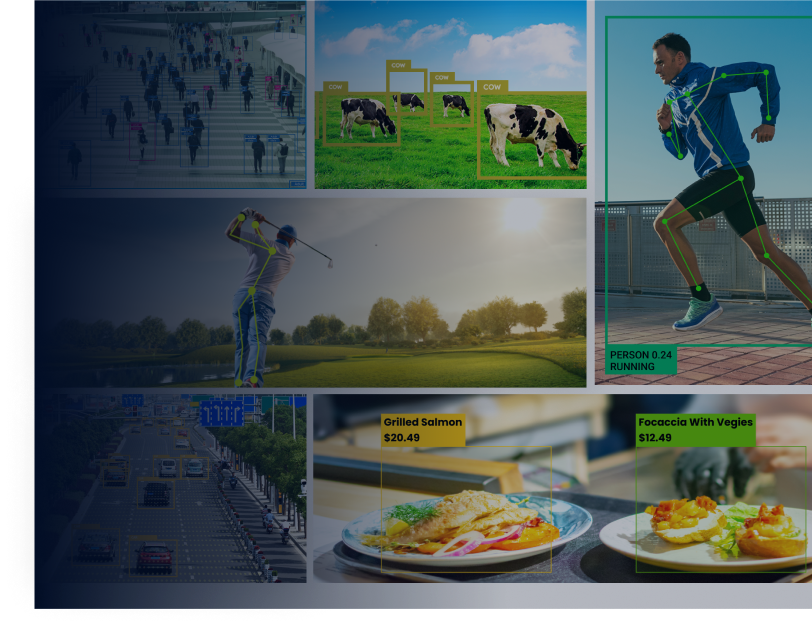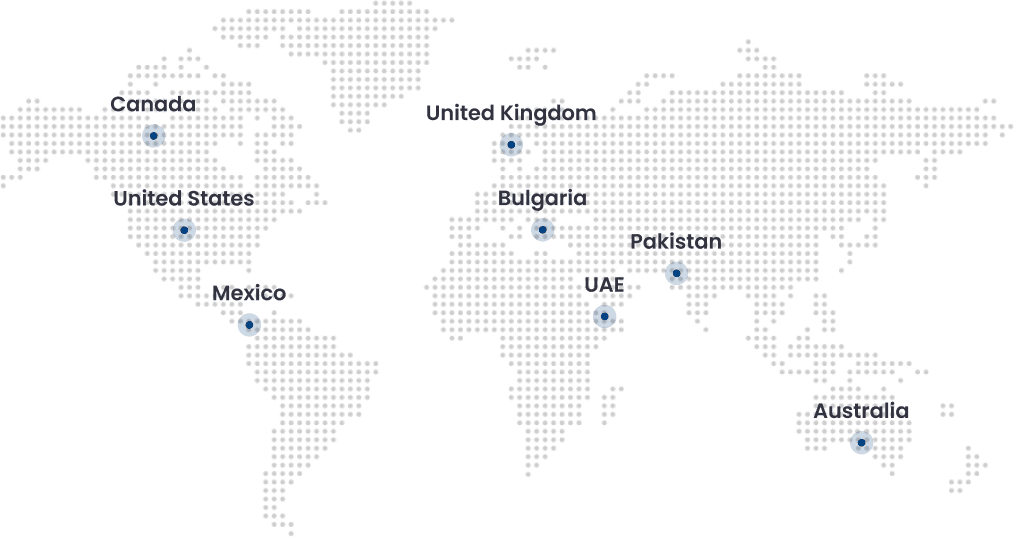ALPR and ANPR are two terms thrown around a lot in the license plate recognition world. Most people use them interchangeably, and they’re mostly right, because both technologies do exactly the same thing. The main difference is simply regional terminology. ALPR is what you’ll hear in North America, while ANPR is the preferred term in Europe and Asia.
Whether you’re looking at automatic license plate recognition for parking management, law enforcement, or smart city projects, understanding this terminology helps you communicate with the right vendors and find solutions built for your region. At Folio3, we’ve built custom ALPR solutions for businesses for toll management, drive-thru operations, parking systems, airport access control, and fleet management, and know exactly what terminology and standards work where.
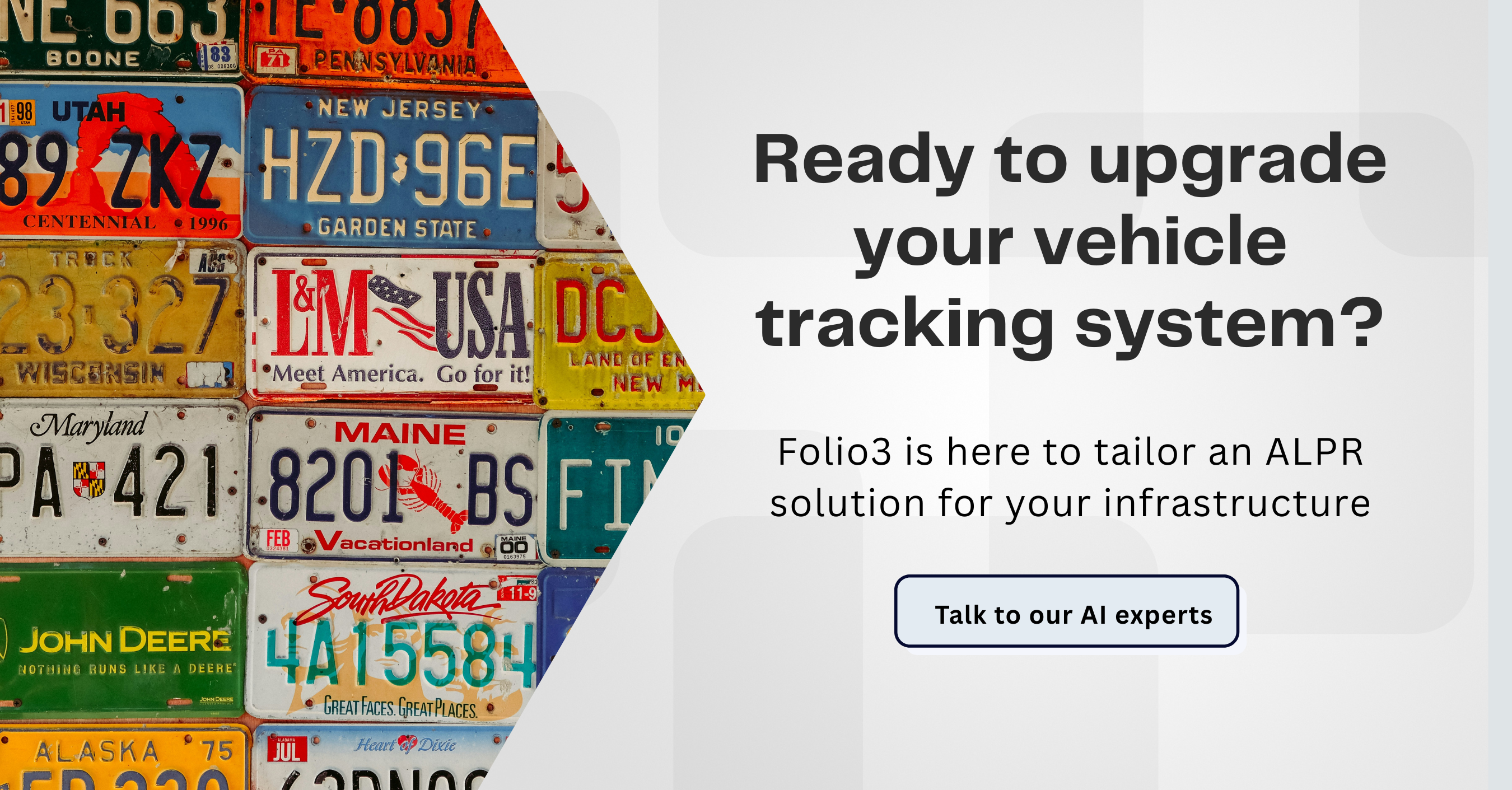
What is ALPR?
ALPR stands for Automatic License Plate Recognition. This technology uses cameras, optical character recognition, and AI to automatically read license plates from vehicles. ALPR is the go-to term in North America, where systems handle specific plate formats used across the US and Canada.
Here’s how ALPR systems work, transforming vehicle images into actionable data for automated responses and security applications.
- Camera capture: High-resolution cameras continuously monitor traffic areas and capture clear vehicle images in real-time across various lighting conditions and weather scenarios.
- AI processing: Advanced machine learning algorithms analyze captured images to detect, locate, and isolate license plates from complex backgrounds with high accuracy rates.
- OCR technology: Sophisticated optical character recognition software extracts and converts alphanumeric characters from license plates into readable digital text for processing.
- Data integration: Processed license plate data connects with existing databases, security systems, and third-party applications to enable automated actions and alerts.
- Real-time response: Integrated systems automatically trigger predefined actions like gate opening, security alerts, access control, or database logging based on recognition results.
Common ALPR applications
Common ALPR applications span multiple industries where automated vehicle identification improves security, efficiency, and operational workflows across North American markets.
- Law enforcement: Track stolen vehicles, identify suspects, monitor wanted persons, automate citation processes for traffic violations, and enhance overall public safety through automated enforcement.
- Toll collection: Process highway tolls automatically without stopping traffic flow, reduce congestion at toll booths, improve payment efficiency, and integrate with electronic payment systems.
- Smart parking: Automate parking facility access control, enforce time limits and restrictions, streamline payment systems in lots and garages, and improve overall customer experience.
- Traffic enforcement: Monitor speed violations throughout city networks, track restricted lane usage patterns, automate red light enforcement systems, and enhance road safety through technology.
- Border security: Effectively screen vehicles at international checkpoints, track suspicious activity patterns, and enhance homeland security through automated vehicle monitoring.
What is ANPR?
ANPR means Automatic Number Plate Recognition. It’s essentially the same technology as ALPR but uses different terminology. ANPR is the preferred term in the UK, Europe, and many Asian countries. The core functionality remains identical, but regional naming reflects local terminology and regulatory requirements.
According to research, ANPR systems can achieve approximately 98% accuracy, which means about two of every hundred cars are not read properly.
Selecting the right ANPR system requires careful evaluation of technical, operational, and business factors to ensure optimal performance and compliance.
- Regulatory and compliance requirements: Different European and Asian regions have varying GDPR compliance, data privacy laws, retention policies, and usage restrictions that impact ANPR system design and deployment.
- License plate format compatibility: Consider local European and Asian license plate sizes, colors, fonts, character layouts, and reflective materials since ANPR systems require optimization for specific regional standards.
- Scalability and performance needs: Evaluate whether you need a single-location ANPR deployment or multi-site connectivity with centralized management, reporting capabilities, and real-time data processing across multiple European facilities.
Common ANPR applications
Common ANPR applications focus on urban management and regulatory enforcement, where automated vehicle identification enhances city operations and compliance across European and Asian markets.
- Urban traffic management: Monitor city center vehicle movement patterns, track congestion levels, analyze traffic flow data, and optimize signal timing for improved urban mobility.
- Congestion charging: Automatically identify and bill vehicles entering restricted city zones, reduce urban traffic, enforce low-emission areas, and support sustainable transportation policies.
- Highway tolling: Process electronic toll payments without stopping traffic flow, reduce bottlenecks at toll plazas, improve journey times, and enhance revenue collection efficiency.
- Parking enforcement: Track parking violations automatically, issue digital citations, monitor time restrictions, enforce permit requirements, and streamline municipal parking management operations.
- Security surveillance: Monitor vehicle access in sensitive government areas, corporate facilities, airports, and critical infrastructure to enhance security and threat detection capabilities.
ALPR vs ANPR: Key differences
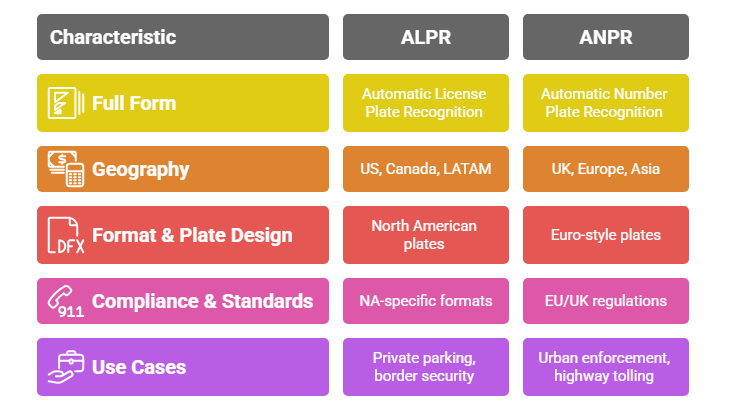
The main difference is terminology and regional focus. Both systems use identical core technology but are optimized for different plate formats and compliance requirements.
Benefits of using ALPR/ANPR systems
Modern license plate recognition technology provides operational improvements across multiple industries. These systems transform manual processes into automated, intelligent workflows that save time and reduce errors.
- Real-time vehicle identification: Instantly recognize and process thousands of vehicles per hour with high accuracy rates, enabling immediate response and automated decision-making capabilities.
- Improved security and automation: Automatically flag suspicious vehicles against watchlists, integrate seamlessly with existing security infrastructure, and enhance overall facility protection through intelligent monitoring.
- Reduced manual intervention: Eliminate human errors and labor costs associated with manual plate checking while increasing operational efficiency and reducing staffing requirements.
- Better traffic flow and analytics: Generate detailed reports on vehicle patterns, peak usage times, traffic trends, and operational insights for data-driven decision making.
- Integration with smart systems: Link directly with enterprise software, access control systems, city management platforms, and third-party applications through robust API connectivity
Common challenges with ALPR/ANPR implementation
Deploying license plate recognition systems comes with specific technical and operational challenges. Understanding these upfront helps ensure successful implementation and optimal performance.
- Plate recognition under poor conditions: Weather variations, inadequate lighting, extreme camera angles, and environmental factors like fog or rain can reduce the system’s accuracy rates.
- Misreads due to plate variations: Worn license plates, non-standard fonts, damaged characters, reflective surfaces, and dirt accumulation create recognition errors requiring advanced processing algorithms.
- Data privacy and legal compliance: Have complex, varying regulations around personal data collection, storage, retention periods, usage rights, and cross-border data transfer requirements.
- Region-specific optimization needs: Different countries require customized machine learning algorithms trained explicitly for local license plate formats, character sets, colors, and regulatory standards.
- Integration with existing infrastructure: To achieve seamless connectivity with new technology, legacy security systems may need considerable updates, custom API development, or hardware replacements.
Factors to consider when choosing ALPR or ANPR
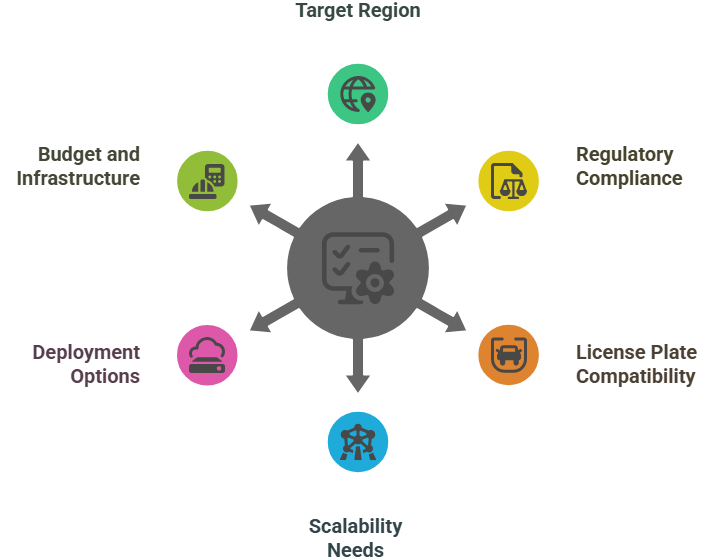
Selecting the right license plate recognition system requires careful evaluation of technical, operational, and business factors to ensure optimal performance and compliance.
Target region and geography
Choose ALPR terminology and systems for North American deployments and ANPR for European or Asian markets where regional terminology affects vendor support optimization.
Regulatory and compliance requirements
Different regions have varying data privacy laws, retention policies, usage restrictions, and legal frameworks that impact system design, deployment, and operations.
License plate format compatibility
Consider local license plate sizes, colors, fonts, character layouts, and reflective materials since systems require optimization for specific regional standards and formats.
Scalability and performance needs
Evaluate whether you need single-location deployment or multi-site connectivity with centralized management, reporting capabilities, and real-time data processing across multiple facilities.
Deployment options
Decide between on-premise installations for enhanced data control and security or cloud-based solutions for easier scaling, maintenance, and remote system management capabilities.
Budget and infrastructure requirements
Factor in camera quality, processing power, ongoing maintenance costs, training requirements, and software licensing alongside initial system investment for accurate budgeting.
Folio3’s Custom ALPR Solutions
Folio3 delivers enterprise-grade license plate recognition technology tailored for your specific market and use case. Our solutions combine advanced AI with practical deployment experience across multiple industries and regions.
- AI-powered customizable systems: Deep learning algorithms optimized for high accuracy across diverse conditions and environments.
- Multi-region compatibility: Purpose-built solutions for US ALPR markets and EU/UK ANPR requirements with local compliance.
- Flexible deployment options: Cloud, edge computing, and mobile solutions that scale from single cameras to city-wide networks.
- Advanced OCR capabilities: Multi-language character recognition with real-time processing and sub-second response times.
- Complete end-to-end platform: Integrated cameras, AI models, analytics dashboards, and API connectivity in one solution.
- Industry-specific applications: Proven deployments across logistics, smart cities, parking management, retail, and law enforcement sectors.
Final Words
ALPR and ANPR represent the same core technology with regional terminology differences. Your choice depends on geographic location, compliance requirements, and specific business needs. ALPR works best for North American markets, while ANPR fits European and Asian deployments.
Both deliver powerful automation capabilities when properly implemented. For enterprise-grade, scalable, and accurate license plate recognition solutions that work globally, Folio3 provides the expertise and technology to meet your specific requirements.
Frequently Asked Questions
Q1: Are ALPR and ANPR the same thing?
Yes, ALPR and ANPR use identical core technology but differ in regional terminology. ALPR is common in North America, while ANPR is used in Europe and Asia. Both systems automatically read license plates using cameras and AI.
Q2: Which is better for my business, ALPR or ANPR?
Choose based on your target region and compliance needs. ALPR works best for North American markets with local plate formats and regulations. ANPR suits European and Asian deployments with region-specific standards and terminology.
Q3: How does ALPR software work?
ALPR software uses cameras to capture vehicle images, AI algorithms to detect license plates, and OCR technology to extract characters. The system then processes this data for automated actions like access control or database matching.
Q4: Can I integrate ALPR with my existing security system?
Yes, modern ALPR solutions integrate with existing cameras, access control systems, and security infrastructure. Integration options include APIs, cloud connectivity, and direct hardware compatibility with most standard security setups.
Q5: Is Folio3’s solution customizable for both ALPR and ANPR?
Absolutely. Folio3’s platform supports both ALPR and ANPR configurations with region-specific optimizations. Our solutions adapt to local plate formats, compliance requirements, and terminology preferences for any global deployment.

Laraib Malik is a passionate content writer specializing in AI, machine learning, and technology sectors. She creates authoritative, entity-based content for various websites, helping businesses develop E-E-A-T compliant materials with AEO and GEO optimization that meet industry standards and achieve maximum visibility across traditional and AI-powered search platforms.

